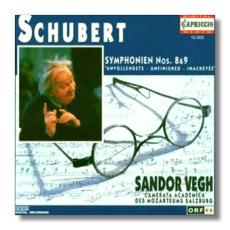
The Internet's Premier Classical Music Source
Related Links
- Schubert Reviews
- Latest Reviews
- More Reviews
-
By Composer
-
Collections
DVD & Blu-ray
Books
Concert Reviews
Articles/Interviews
Software
Audio
Search Amazon
Recommended Links
Site News
 CD Review
CD Review
Franz Schubert

Symphonies #8 & 9
- Symphony #8 "Unfinished" in B minor, D. 759 (1822)
- Symphony #9 "Great" in C Major, D. 944 (1828)
Camerata Academica des Mozarteums Salzburg/Sándor Végh
Capriccio 10503 1994 DDD 76:50
In reviewing Naxos' recording of Schubert's Ninth Symphony with the the BRT Philharmonic Orchestra, Brussels (8.550502), I disparaged Alexander Rahbari's headlong tempi. With only a few exceptions, they dispelled the symphony's abundant mystery and diminished its majestic power. Beside that hare, Sándor Végh's performance is a tortoise, but on that account alone it doesn't win the race. It beats Rahbari handily, but there are lots of other runners.
The slow introduction to the first movement and the second movement are exceptionally slow, the second movement occasionally flirting with catatonic immobility. As in the first movement proper, nuance is sacrificed to a perverse ponderousness. That weight crushes nuances that could keep the music moving even at this tempo. The scherzo, however, seems just right – it bounces along scarcely touching the ground, and the trio appears in a very becoming rustic garb. Like the first movement, Végh's finale substitutes weight for wonder. Paradoxically, the connections with Beethoven's symphonic style are clearest in those sections, like the scherzo and trio, when Végh lifts his foot from his prey's neck.
The eighth symphony, with which this one is paired, suffers from similar pachydermatous pretensions. The pizzicato accompaniment to the opening few measures, for example, retards the motion from measure to measure. And in Schubert, square as he can appear on paper, it's what lies between the notes that counts. There is piercing sweetness between the notes of the second movement's woodwind solos, but those solos are too short for their emotion to spill over into the rest of the movement, and they're trampled too quickly by the rogue elephants.
Capriccio's recording, taped in the Mozarteum, reveals lots of detail. In fact, it reveals too much – not just too many stray sounds of page turns and musicians bumping music stands, but too much of the orchestra itself. When the strings don't blend, every unbraided strand tweaks a raw nerve ending. During the great climactic moments, however, the performance sweeps everything before it, and so does the recording.
The playing is unvarnished and heavy-handed, but I have a hunch that these symphonies sounded that way to their earliest audiences. Still, many generations of orchestral refinement should have taught us something. During those years when I could afford only one recording of each work, I chose Reiner's Unfinished and Klemperer's Great C Major. I still would.
Except for Capriccio's exceptionally revealing recording, which ushers you to a seat in the orchestra itself, this disc offers little that has not been expressed more eloquently by somebody else. That little is all in the scherzo of the ninth symphony, and it's worth hearing. But how much is 10:05 out of 76:50 worth to you? It depends on the depth of your collection and your love for Schubert.
Copyright © 1996, Robert Maxham


















